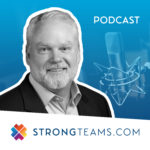About the Podcast
The StrongTeams.com Podcast is produced by Ministry Insights International. Your host is Rodney Cox, president of Ministry Insights, and author of the book Leading From Your Strengths®. Rodney and his guests discuss best practices in building strong teams—teams built on empathy, understanding, and trust, where every team member feels valued and contributes at the highest level possible.
Episodes are also available on our YouTube channel.
Frequency is biweekly. We publish new episodes every other Monday.
Learn how to subscribe to or follow a podcast.
Recruiting is a challenging but crucial aspect of building a solid team. A lot is riding on the people you hire. They could make or break the success of your organization.
While some ministries and organizations do an excellent job recruiting and hiring the right people, most don’t. According to a study by McKinsey & Company, 82% of organizations don’t believe they recruit highly talented people, and only 7% think they can retain them.
That’s a rather bleak statistic.
So then how do you recruit the people you need to accomplish your organization’s goals, allow them to flourish, and then retain them?
Two essential things must be in place to build a highly effective team. First, you must know the team’s purpose, and second, you must see the potential of the individual you’re hiring – before you hire them. So the sixty-four thousand dollar question is this:
What are you objectively doing today to discover what you need so you can realize the potential of a candidate before you hire them?
Many of us unintentionally put the cart before the horse. We start recruiting before we know why and what we need to recruit.
Know why you’re building your team.
Start by understanding the purpose of your team and why you’re recruiting in the first place. That may sound simple enough, but knowing your team’s purpose is the foundation for everything you do. Once you have a clear idea of why you’re building your team, you can focus on who you need to recruit. Using our Position Insights Profile Job Benchmark will help you understand what type of temperament your ideal candidates should have to help you accomplish the why.
Strategically advertise for the right individuals.
Recruiting for specific outcomes should never be a one size fits all approach. Many organizations fail to target the right individuals with the right messaging and then wonder why their efforts fail. It’s essential to tailor your approach and get specific to attract the high-value people you’re seeking. It will also help to weed out any applicants that don’t fit.
Go beyond the resume.
An ideal candidate may look good on paper with a stellar resume, but that doesn’t automatically mean they will fit into your organization’s culture. You’ll want to dig a little deeper into each candidate’s temperament to see if they match the team’s needs. Adding our QuickScreen Assessment is an easy way to screen applicants and drive purposeful interactions to help uncover potential candidates’ character, competencies, and chemistry.
Include current employees to help with your search.
Your employees are significant assets when it comes to recruiting new individuals. Be sure they know why, what and who you’re looking to fill a position before starting the hiring process. Chances are you will increase your odds of hiring the right person. Also, the Position Insights Process will ask you to consider inviting a few employees to join the hiring team for valuable insight.
Think long-term.
Don’t dismiss good talent just because they aren’t the exact fit for the role you’re looking to fill. If you’re lucky, you may find a candidate through your hiring process who could be the right fit down the road. When you find a valuable candidate, continue to communicate and establish a rapport with them so when you’re ready, they’re primed for the hiring process.
Develop a strong hiring philosophy and leave a good impression.
Standardize your hiring process and establish a suitable method so you always leave a good impression. Every potential candidate should leave feeling good about your organization whether you plan to hire them or not.
Recruiting top talent doesn’t have to be so hard. By adding a few key steps to your hiring process, you can build a strong team that works successfully together.
To effectively target the ideal candidates for your team, use our hiring tools!
The Successful Staffing Guide, Position Insights Profile and the QuickScreen Assessment.
Did you ever imagine how difficult it would be to expand your current leadership skills to include being a digitally savvy leader so you could manage a team working remotely?
You wouldn’t be alone. Many leaders have struggled to adapt and innovate their approach to building a high-performance team remotely.
Because there’s a lot to know about managing a team and getting work done remotely when you can’t see and talk to your people in person, processes feel a bit bumpy, productivity slows down and hard to measure, and people can be easily distracted and disengaged.
How do you keep everyone focused and on task when there’s a connection void that is hard to fill?
Remotely leading a team in a digital space means you need to become a slightly different leader. Understanding your leadership strengths is always a good place to start. Still, it’s also important to develop best practices for keeping your team connected, aligned, happy and productive when you can’t be physically present with one another.
1. Connect Using Video
While we are all burned out with virtual meetings, it is more important now than ever to keep your video on. Your team needs more than just your words in a meeting; they need to see your smile and body language. So turn that camera on and zoom out. Let them see that you are still leading and not just a face on the screen. Invite them to do the same. It may not be as good as the real deal, but using video is excellent for face-to-face interactions with your team. Choose a good video conferencing service that your entire team feels comfortable using. Zoom, Google Meet, and Microsoft Teams are the most common and easiest to use.
2. Have a Daily 20 min Check-In
This may seem excessive, but daily checking in with your team keeps everyone engaged. Reserve the first 5-10 minutes to talk about life, not work. Keep it light and unstructured. Then take another 10 minutes to talk about what everyone is working on and clarify tasks to keep things on track.
3. Create Spaces to Chat Online
When you were all in the office together, your team may have had impromptu brainstorming sessions or chatted ideas over lunch and coffee. You can recreate that kind of magic through an online messaging platform like MatterMost, Slack, Google Chat, and Microsoft Teams. Any of those – or something similar – will give your team a secure place to talk about projects or have quick casual conversations.
4. Practice Time Blocking
Working from home can be tricky. Especially if there are other family members like children present during working hours. Blocking work hours can help team members divide time between work and family without losing their sanity. It’s also helpful for focus and managing energy levels.
5. Develop Work Rhythms and Limit Distractions
It’s hard not to be continually distracted when working remotely. Stopping work to answer a text or an email can seem harmless at first, but it can also quickly get out of hand. Set boundaries for team correspondence and suggest your team turn off their phone notifications while they’re working.
6. Embrace Being Flexible
Finding new normals in the workplace will look different for each member of your team. Some may need to change up their environment; others may need to work unusual hours. Even if it’s challenging and frustrating, stay open and flexible to how your team tackles their work. Invite your team to be flexible as needed but also let them know how they will be held accountable.
7. Outfit Your Team With Digital Necessities
Does your team have all they need to be successful in the digital world? Consider setting aside part of your budget to ensure they are set up properly with good WiFi, laptops, headsets, webcams, training, and other resources.
8. Understand Each Individual’s Strengths
Understanding the strengths and weaknesses of your team will help you stay connected with your team members. Know what frustrates them, what challenges them and what they need in order to deliver great work and feel part of the team. Explore our range of team assessments if you’re looking for ways to get to know your team more!
9. Be Empathetic
Your team is a unique group of individuals who all handle stress in different ways. Sometimes it’s easy to spot when someone is struggling, and sometimes it’s not. Be mindful that your team may need more breaks or time off than usual. Be patient and empathetic while they also learn to adapt and manage a new way of working.
10. Take Time to Celebrate and Have Fun
Give your team things to look forward to. Keep morale up by scheduling fun meet-ups or throw a party over zoom. Get creative. And be sure to recognize and celebrate important milestones like birthdays and anniversaries.
Adapting to a new way of working and leading teams isn’t easy. We hope these tips will help you and your team to build connection, camaraderie, and resilience in a new way.
If you’re looking to improve how you lead your team remotely, then take our Leading From Your Strengths assessment today.
The Ministry Insights Strengths-Based Leadership assessment tool will help you understand your strengths as a leader, those of your team members, and how these strengths can guide everyone to work better together while managing the new demands of a digital workplace.
Authors: Rodney Cox, John Trent, Eric Tooker
Format: Hardcover
Is your small group struggling to reach its potential?
Being part of a small group can be a bit like climbing a mountain – it has risks but the payoff is immense. That is why Trent, Cox, and Tooker have styled this book, the second in the Leading From Your Strengths™ series, like a mountain climbing expedition. Just like climbing Mount Everest, climbing the mountain to intimacy in your small group involves five stages or camps. You begin at your “base camp” commitment, and then move through the various stages of honesty, acceptance, closeness, and finally the mountain’s peak of intimacy. Once again, the Ministry Insights team will be your expedition guide on your climb as you learn to leverage your strengths for effective and successful small group experiences.
Pastor Marty Tobin and his wife Debe have been leading marriage workshops for more than two decades.
Typically, at the close of each session, workshop participants crowd to the front to speak to the couple. Some ask for additional counseling. Others ask the Tobins to speak at a retreat or invite them to their church to present a workshop. More than once, husbands and wives who were on the verge of a split prior to the conference are now committed to reconciliation and ask for guidance.
One day, a retreat participant approached the Tobins with a different request. Would they consider conducting a team-building workshop using the Leading From Your Strengths profile and process with her staff? Since the Tobins had experience facilitating Leading From Your Strengths workshops with other small businesses and teams, they didn’t think twice. Of course, they’d be willing.
But the request wasn’t for a ministry group or a commercial business team training. It was for a workshop using Leading From Your Strengths with the staff of a local elementary public school. The school administrator saw how the LFYS content could impact her team.
That invitation opened the door for the Tobins to impact hundreds of teachers in local schools … who in turn, influence children and families every day.
It Started With the Lion, Otter, Golden Retriever, and Beaver
In the 1990s, Marty and Debe were introduced to the four temperaments described by Gary Smalley and John Trent in their groundbreaking work, The Two Sides of Love (1990). The LOGB model characterizes four major personality types as animals: Lion, Otter, Golden Retriever, and Beaver. “That model revolutionized our marriage,” says Marty. “As we used it in our coaching and counseling, the LOGB model brought clarity to many couples with whom we were working.”
Soon, the Tobins became aware of workshops led by John Trent and Rodney Cox that incorporated the LOGB model into what is now known as the Leading From Their Strengths process. Ministry Insights had created a suite of products that made the strengths concept accessible to couples, families, and teams. Together, Marty and Debe became certified in LFYS Level 1 and Level 2 as well as the Different By Design marriage curriculum.
Soon, the Tobins incorporated the LFYS process into a variety of ministry environments. In Marty’s role as an executive pastor, he uses the profiles as a regular part of team-building as well as in the hiring and onboarding process. Together, he and Debe work through Marriage Insights profiles with engaged couples as well as for couples in counseling. And the profiles are a key element in Different By Design marriage conferences that Tobins lead in one-day events and during retreats. Marty typically presents the nuts and bolts of the material and Debe adds stories and depth.
It was during a Different By Design conference that the school administrator approached Marty and Debe about ministering to public school teachers, staff, and administrators using LFYS.
Build Understanding With One Simple Question
As a result, Marty and Debe led a team-building workshop for this elementary school staff, which included individual grade level steam sessions along with administrators. “We were privileged to have a front-row seat as these teachers’ attitudes changed,” says Marty. “They acknowledged differences in other team members, which they’d previously seen as weaknesses, and saw how those differences were strengths that benefited the team.”
One kindergarten team included an Assertive problem solver – a Lion – who was unaware that she continually took over decision making without considering the Reflective nature of other team members. Another team was packed with Optimistics – “Otters” – who processed information with plenty of enthusiasm while having lots of fun and fellowship together. Yet without a Realistic on this team, the members struggled to follow through and complete their lesson planning.
The Tobins used a simple question to build understanding in these diverse teams: “As you begin the day, what is your ultimate goal?” Teachers listened carefully to each other’s answers and came to a greater understanding of how they might learn from each other, rather than compete or be in conflict.
Not only did the workshop build greater team unity at different grade levels, but the principal later reported that he used the profile content to communicate more effectively with each teacher in ways he or she could best receive and respond.
And now, the principle of strengths can filter down to students and families.
One of the Most Rewarding Experiences
Since then, referrals have led to additional opportunities. Marty and Debe have conducted workshops with four school teams – three public schools and one private school – with staff ranging from 39 team members to 61 team members. Debe’s 25 years of experience as an educator brings real-life relevance to the sessions.
Yet no matter who they’re working with – families, couples, teams – Leading From your Strengths is the first tool the Tobins use to get the process going. The profiles give clarity, build unity, and highlight the value each individual brings to a team and each spouse brings to a marriage – and they’re based on biblical principles.
“We could share many stories of enlightenment moments that we’ve experienced as couples and team members use the Leading From Your Strengths profiles,” says Marty. “But working with school teams has been one of the most rewarding.”
Which demonstrates how God can use one area of ministry to move you into another.
More Ways to Use the Profiles
How Seminary Uses Profiles: “I Wish I’d Started Using Them Sooner”
How CCV Uses Profiles to Equip Pastors and Leaders for the Long Game
How Profiles Make It Easy to Coach Both Secular and Faith-Based Clients
Strong teams are built with purpose
Find the right people, gain understanding, and release people to flourish.
Our assessments and training exercises will help release the full potential of your teams.
Most Popular!Our most comprehensive report: includes a detailed analysis, communication preferences, value to the team, areas for growth, ideal work environment, and more.
Discover Your StrengthsA 6-step guided assessment to help you define a position to ensure the best hiring process. Identify the key strengths needed for each role on your team.
Define the JobA fast, one-page analysis for candidates and new hires. Compare candidates to a Position Insights report and onboard new hires.
Screen CandidatesThis course can be used with any size team. The content can be self-paced or assigned to drive more of an interactive experience.
Build Strong TeamsDiscover Insightsfor Marriage
Discover Insightsfor Small Groups
As a local church pastor for twenty-five years, Michael Lee was no stranger to personality differences in his congregation. Plus, his undergraduate degree in psychology had introduced him to dozens of kinds of personality assessments and tools.
But even so, when Michael enrolled in the Doctor of Ministry (DMin) program at New Orleans Baptist Theological Seminary, he was not aware of the impact the strengths movement could have in relationships and teams. It was in the DMin program that Michael was introduced to Leading From Your Strengths profile for the first time.
“I was amazed at how clear and helpful the results are,” says Michael. “I say that not to denigrate other instruments out there, but because LFYS is the most comprehensive and useful tool I’ve encountered.”
Even though Michael and his church staff worked well together, nevertheless he used the profile with the team which in his words, “brought about even better communication and unity.”
Then Michael had the opportunity to use the profile with many more church teams and leaders than he imagined … and help them move from being simply okay to being vibrant and healthy.
Don’t Hinder Others: Profiles Make A Good Thing Even Better
Michael was halfway through his DMin program in 2015 when the Mississippi Baptist Convention Board (MBCB) called him to leave local church ministry and serve on MBCB staff. Soon afterward, in 2017, Michael traveled to the Ministry Insights Equipping Conference to become certified.
Now as executive director of the MBCB church growth division, Michael has a staff of 30 and uses the profile both for team building and with his direct reports. “I want to understand them better,” says Michael. “But also, if there is anything we need to address, I can do so in a nonthreatening way.”
Yet what has surprised Michael the most is how the profiles help him with personal responsibilities, particularly as he works with his ministry assistant. “She is fantastic, and we get along well,” says Michael. “But I didn’t know that there were ways I approached our work that was hindering her.” Michael’s hands-off management style allows staff the freedom and latitude to do things the way that is most comfortable for them. Yet his assistant works best with a specific direction given in a timely way. “I was being too broad and general with her, which created extra stress,” says Michael. Once he discussed his assistant’s data with her, Michael changed his approach. Now, he offers her a couple of options for ways to do things. She can focus on the tasks that are most important to complete without the stress of determining which option might be best for her boss.
“Just this one change has made her less stressed,” says Michael. “It’s been incredibly helpful for both me and her.”
Don’t Just Mark Time: Profiles Move Teams Off a Plateau
MBCB partner churches routinely ask for help from the church growth division as they face stagnation or plateaued growth. It’s here where Michael and his staff step in to offer counsel.
The LFYS profiles, says Michael, have led to some key breakthroughs for these church teams.
Recently, he met with a church team that had experienced a good bit of growth coupled with considerable staff changeover. The staff was equally represented by men and women and range in age from late 20s to mid-60s. While there were no overt conflicts among the staff, they were not operating as a team and had hit a growth ceiling.
As Michael led the staff through a three-hour LFYS experience, the lead pastor was able to share openly with the team in a way he had not until that point. Were they on board with his ideas energetic, fast-paced approach? The group looked at their Strengths Wheel and saw that most of the rest of the team needed time to process ideas at a slower pace than the lead pastor. When he wanted to move quickly, they felt they couldn’t catch up. Soon, team members began to feel incapable of handling what he asked them to do.
“It was a true ‘aha’ moment,” says Michael. Even after the team building session, when Michael joined the team for lunch, the discussion continued. Staff members apologized to each other for common problems and hurts. They laughed and enjoyed each other.
Since then, staff members have changed how they communicate and interact with each other. “They’re moving forward in a healthy way and the church has broken its growth ceiling,” says Michael. “Yet without intervention, they would have struggled to resolve these communication issues and hampered the church’s ability to grow further.”
Don’t “Settle”: Profiles Dispel Ignorance
Ministry leaders have been taught excellent fundamentals in so many areas, says Michael, such as sermon preparation and managing meetings, yet lack exposure to the strengths movement.
“Take me, for example,” he says. “I have a degree in psychology, but only in recent years learned about finding, using, and blending my strengths with others.” That ignorance contradicts the 1 Corinthians 12 teaching of each individual’s giftedness and can even stunt the church.
“The Leading From Your Strengths profiles are not just to be used in a crisis,” says Michael. “Any team can use them and move from okay to vibrant and thriving.”
In his experience, any team benefits tremendously from collecting and using the data. In fact, teams and relationships that are good – like the relationship he enjoys with his ministry assistant – can move into rich, vibrant, mutually-supportive magnets of growth when users understand and appreciate each other’s strengths.
“Unless we understand ourselves and our place in the body of Christ, we will miss out on spiritual opportunities and miss out on the unity Christ offers us,” says Michael.
Which means we needn’t settle for “just okay” when our teams can be great.
More about Building Healthy Church Teams
Profiles are a Catalyst for Healing in This Local Church
Pastor-Turned-Administrator Uses Profiles to Build Church Community
Profiles Help 3 Pastors Successfully Transition to Team Leadership Model
By Don Cruickshank
“How do they keep beating us?”
“We should be able to run over them!”
Members of my high school basketball team had the same discussion year after year as we consistently lost to a smaller school’s team.
One of the opposing team’s players could only score when he was positioned five feet from the basket. Their small guy could never get close to the hoop without getting crushed. If there ever were a rag-tag group of individuals that when assembled made an outstanding team, then it was them.
So how did they do it?
It was not that the other team had a greater talent pool than us. We had more well-rounded players, while each player on the opposing team had just one or two strengths.
But the other team had a more insightful coach.
He positioned the big guy under the hoop to collect rebounds and pop them into the basket because he was now close enough to score. Meanwhile, the scrawny kid could not get close to the hoop, but he shot accurate three-pointers. He stayed on the fringes and scored repeatedly.
Their coach knew that each person on the team was like a chess piece. He fully leveraged each player’s strength so that the team operated well together on his section of the board.
Your Hidden Competitive Advantage
The most successful organizations are not made up of “well-rounded” people!
Highly successful organizations are actually made up of people with different strengths who are allowed, encouraged, rewarded, and empowered to fully bring forward their strengths.
Yet while many businesses and organizations believe that truth, but do not know how to put it into action.
They measure their employees’ strengths. Yet once the data is in, these organizations don’t know how to activate it.
There is a direct correlation between employees’ strengths and employee engagement, according to Tom Rath and Barry Conchie in Strengths Based Leadership (Gallup Press, 2008).
When an organization’s leadership does not focus on finding and using an employee’s strengths, the chance that the individual will be engaged is only 9%.
However, if the organization does focus on using an individual’s strengths there is a 73% likelihood that he or she will be engaged. Furthermore, engaged employees in Canada are reported to give 54% more effort (Gallup, 2017).
If there was ever a competitive advantage to have, this is it.
Leverage Your Team Members’ Strengths
Over and over I have seen leaders and teams benefit from the Leading From Your Strengths process.
Each team member completes the Leading From Your Strengths assessment and receives a personal 20-page report.
But that’s just the beginning. The report reveals personal and leadership strengths and weaknesses along with each member’s General Characteristics, Value To The Team, Checklist For Communicating, Don’ts On Communicating, Ideal Environment, Keys To Motivating, Keys To Leading, Areas For Improvement, Self-Perception & Other’s Perception, How You Are Having To Adapt.
That’s a wealth of information.
That’s why the Leading From Your Strengths approach is called “a process.” The complete process includes working through the reports together as a team. Then once you know your team members’ strengths, how can you empower each individual to use those strengths?
One key is coaching.
As I coach a team, together we break down assumptions, perceived or actual, that are blocking team members from fully using their strengths. The leader and team members both are empowered with strategies on how to move forward using their individual strengths to blend.
The process is similar to building a strong athletic team. A good coach knows each athlete’s strengths and by using that information, he determines where to place that person and how to motivate him to perform for the good of the team.
That’s what happens when leaders and teams activate their strengths-based data. Like the coach of my high school team’s opponent, the leaders I coach learn how to leverage their team members’ strengths.
It’s always a good idea to know your team members’ strengths. But don’t stop there.
Leveraging that data will give you a competitive advantage, not to mention a healthier, more engaged team.
*This post first appeared on Don’s website, DC Leadership Training and Consulting.
More About Coaching
Lieutenant Colonel Philip “Buddy” Winn, U.S. Army chaplain, leads ministry teams serving soldiers and their families of Task Force Spartan, comprised of active and reserve Army and National Guard units.
His job mushroomed recently when troops from Task Force Spartan were deployed to the deserts of southwest Asia as part of Operation Spartan Shield (OSS).
“Leading From Your Strengths has strengthened relationships on the team,” said Buddy, noting the importance of cohesiveness in a military unit. “The process has added value to how we support the unit, staff, and command teams.”
Use The Assessments in Teams to Be Collectively Strong
A close friend introduced Buddy to the Leading From Your Strengths profiles. “He said the profile would help me understand more about myself,” said Buddy. “He was right.”
When Buddy first reviewed his report, his first thought was, Who talked to my wife? “It was astounding how the profile articulated my unique characteristics and strengths so clearly,” he said. The benefit was so obvious that Buddy went on to use the profile with his staff team of five faith professionals.
“It’s essential as leaders that we be strong collectively,” he said. “Whereas I am not a detail-oriented person, I can count on my more systematic teammates to provide that quality to the team. Meanwhile, since I’m strong in integrating technology and relating to external partners, I take the lead there.”
Use The Assessments to Validate Each Member
Word spread within the unit’s headquarters by those found value in LFYS and were positively impacted. Soon, Buddy and his team began using the profiles with others. They set up rounds of intakes followed by short “blocks of instruction” that demonstrated each team’s combined strengths.
Buddy discovered that unit members usually respond to the profiles in one of two ways: (1) the individual believes their spouse had been asked to fill out the information because it is so accurate or (2) the individual feels validated. “The report acknowledges certain characteristics or strengths the user knew he possessed, but that others either ignored or even downplayed as a weakness,” said Buddy.
Group debriefings lead to many smiles and head-nods, further affirming individual profile results and boosting team members’ confidence. Those debriefing sessions allowed members to identify which individuals on the team possess specific strengths, leading to discussions about how to leverage those strengths based on the team’s mission.
A good example is Task Force Spartan member Chief Warrant Officer 3 Keith Schweitzer, who recently completed degrees in organizational and strategic leadership and now leads a human resources team of six soldiers who represent a wide diversity in gender, ethnicity, education, and experience.
“As part of my degree curriculum, I was required to complete a myriad personal and leadership assessments,” said Keith. “The LFYS assessment and profile are among the best I’ve seen.”
He was amazed at the accuracy of his own LFYS profile. His team’s assessments also helped him to better understand the strengths of his teammates, said Keith. “Sharing their individual results was a personal and emotional event for some on the team,” he said. “But the payoff is improved communication, improved expectations, and improved clarity for each member.” Keith and his team are now learning to maximize each one’s strengths as they work together.
Use The Assessments Sooner Than Later
Buddy’s advice for other leaders? “Start by completing the profile and experience how much it can tell you about yourself,” he said.
Then use it for your team. The payoff is high for a relatively small investment of time and money, said Buddy, adding, “You won’t be disappointed.”
In fact, these soldiers say you will be disappointed if you wait rather than proceed.
Keith’s words sum up that sentiment for Task Force Spartan: “I only wish we would have taken the assessment and shared our profiles earlier during our deployment.”
More about Building Teams
Profiles Help Australian Pastoral Care Givers Serve Hurting Patients, Families
Profiles Transform Entire Canadian Church and Community
Profiles Lead to Successful South Dakota Team Building Retreat
Jon Taylor moved into the lead pastor role at First Christian Church of Phoenix during a major staff transition: the church shifted to a team leadership model.
Two factors helped pave the way for the transition. First, Jon had been serving at the church as executive pastor, so he was already familiar with the staff and ministry. And fortunately, Jon had recently read Leading From Your Strengths: Building Close-Knit Ministry Teams by John Trent, Rodney Cox, and Eric Tooker and then completed his own Leading From Your Strengths profile assessment.
The Leading From Your Strengths profiles, says Jon, played a key role in the team’s successful transition to the new staff framework.
Data Helped 3 Pastors Transition Well Together
Three pastors, including Jon, formed the new executive leadership team. Together with the rest of the staff, they completed their profiles and attended a Leading From Your Strengths event where they walked through the results under the guidance of Rodney Cox.
“We had some powerful ‘ah ha!’ moments,” says Jon.
Those moments allowed the trio to gain understanding of each other’s strengths, paving the way for a smooth transition. Each had different roles – in teaching, development, and administration – but “we had to learn to work as a unit,” said Jon.
Jon’s profile showed a strong bent to reflective problem-solving. He takes time and considers all options and angles before moving forward. One of his co-leaders, however, makes decisions quickly and firmly, which explained his high score as an aggressive problem-solver.
“It was uncanny how the scores showed we could balance each other,” says Jon. In one instance, when a conflict arose with a staff member, the aggressive co-leader was ready to take action immediately. Jon, however, encouraged caution. “Literally the next day, as we sat down for a meeting, my co-leader told me it had been right to wait,” said Jon. On other occasions, Jon’s co-leader came to him with these words: “You have been thinking about this one particular issue for a while. It’s time to pull the trigger one way or another.”
Humility was the key to putting the profiles into practice, says Jon. Each of the three leaders understood his strengths and did not set them aside. Instead, they were able to recognize when another team member’s approach was the best way and yield to it.
Data Helped Team Members Affirm One Another
Jon subsequently obtained certification as a LFYS facilitator and used the profiles several times for team building with his staff. Most helpful were the moments when each member self-identified one or two sentences on their individual reports that are most important to them. “By articulating one or two sentences, each staff member communicated what they wanted others to value in them,” says Jon. “Co-workers affirmed those strengths in that moment and thereafter, too.”
The FCC staff went further with the LFYS process by using Position Insights to write job descriptions for new staff openings. While they did not choose new staff solely based on their profiles, the assessments were part of the interview process with candidates. Then together the entire team plotted their strengths on the Strengths Wheel and identified gaps in strengths to articulate how they must compensate together.
Data Helped Individual Leaders Have a Voice
When one Type A-personality elder pressed Jon to develop an aggressive leadership style, Jon was able to use the data from his profile to put together a document that explained his strengths and how those strengths could benefit his team as a leader. That document paved the way for a frank and helpful conversation with the elder. Jon was able to express confidence in the elder’s ability to receive the information and use it because the document provided concrete ways Jon interacts and communicates best.
“The profile gave me the language and data I needed during the transition and beyond to express myself,” says Jon.
Soon after beginning to use the profiles with his staff, Jon became interested in coaching. His first clients found him through the church and via referrals. He uses the LFYS assessment as a discovery tool to supplement the coaching process, particularly in life purpose coaching, and now in his work with Coaching Mission International to provide coaching support, encouragement, and feedback for cross-cultural mission workers so they can complete their calling.
“LFYS helps individuals to discover their strengths and helps teams to function better,” says Jon. “I am a huge fan and I strongly recommend any coach, pastor, or leader to use this tool in their ministry.”
More About Successful Transitions
Successful Team Transition Prompts Leader to Use Profiles Worldwide
Canadian Leader Helps Teams, Mid-lifers Transition Well
Team Leader Uses Profiles to Onboard New Members








